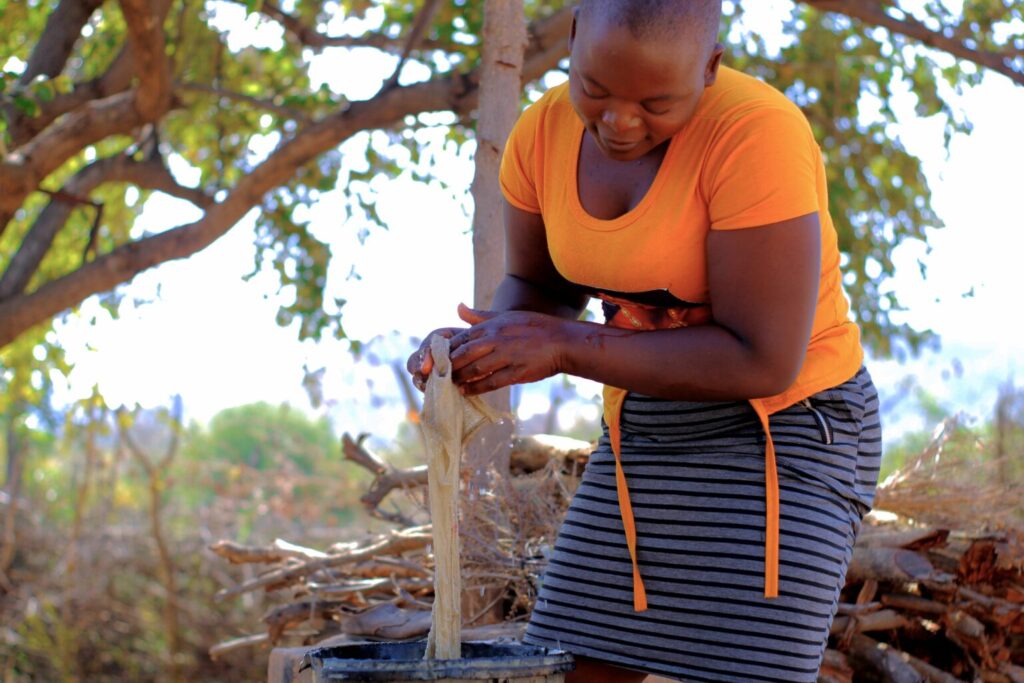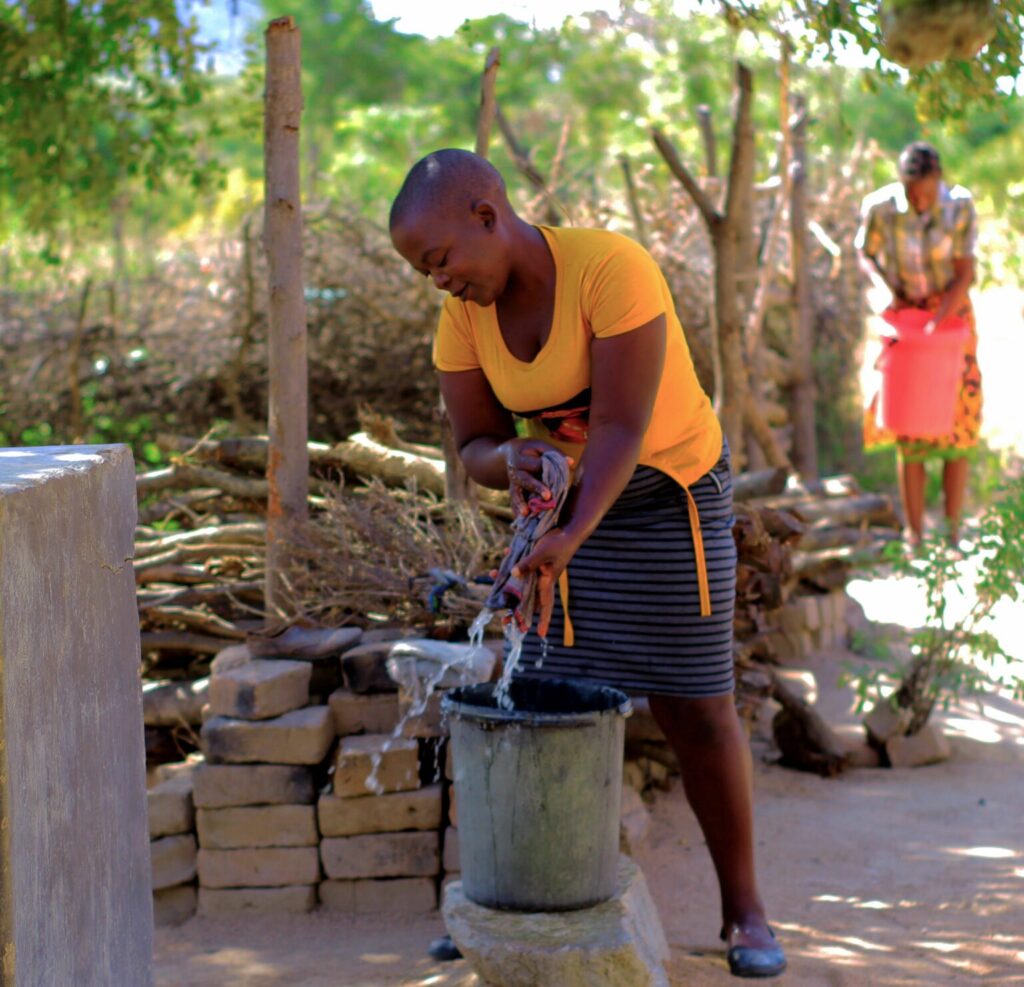Married Off At 13, Suffered Obstetric Fistula At 15 After A Complicated Delivery, Read The Story Of How Theresa Treated The Condition Despite Criticism From Her Church And Community

At 15, after a complicated delivery, a Zimbabwean woman suffered an obstetric fistula, which hindered her from living a full life.
This is a story of how Theresa Kadzura was able to beat negative attitudes towards formal healthcare in her church and community to face obstetric fistula.
Obstetric fistula is one of the most serious and tragic childbirth injuries. A hole between the birth canal and bladder and/or rectum, it is caused by prolonged, obstructed labour without access to timely, high-quality medical treatment.
It leaves women leaking urine, faeces or both. Women who experience obstetric fistula suffer constant incontinence, shame, social segregation, depression, chronic health problems and deepening poverty.
It may be winter but temperatures are soaring at a homestead in Chikwariro, a low-income village in dry, arid Marange in Eastern Zimbabwe on this Sunday morning. Bending over a bucket next to a pile of firewood, Theresa Kadzura, 29, is vigorously washing worn-out pieces of cloth from old towels and t-shirts with plain water.
Despite their worn appearance, these pieces of cloth are important to Kaduza. She wears them in place of adult diapers to help manage a condition she developed during childbirth in 2009.
When Kadzura obstructed labour in 2009, she was fifteen years old, and her labour lasted for five days.
Like many girls from her church, the Johane Marange Apostolic Church, Kadzura had been married off to a church member at 13.
After falling pregnant, Kadzura was expected to deliver her baby at home, thanks to a rule at her church, which forbids members from going to the hospital.
Her mother-in-law was an untrained church midwife and would supposedly help her have a safe delivery. However, the delivery she had was far from safe.
Kadzura recounts the five-day-long labour horror that almost ended her life. She shared:
“It was on a Monday morning, and I felt a sharp pain similar to period cramps. It lasted for a short time, so l didn’t think it was serious. I alerted my mother-in-law who then told me that I was in labour. Later in the night l felt okra-like fluid coming out of my vagina.
On Tuesday morning, my mother-in-law said I was taking long to dilate and assumed that my pelvis had not opened enough to let the baby come out.
So she took me to a secluded place in the garden to try to widen my pelvis by inserting a clenched fist inside my vaginal canal. But as I laid on my back and lifted my legs to grant her access, the placenta came out…and l blacked out.”
After blacking out on Tuesday, Kaduza went into a coma, still with the baby in her womb. On Friday, she was ferried to the homestead of the church’s highest priest at St. Noah, 3 kilometres from her in-laws’ homestead.
Another untrained church midwife was called to assist at the chief priest’s homestead. She inserted her hands inside Kadzura’s vaginal canal and forcefully pulled out the baby. The baby had already decayed in the womb, and no longer had skin and hair. It was buried at a place unknown to Kadzura.
Obstetric fistula is a medical term for a tear that develops between the vagina and the bladder (vesicovaginal fistula) or vagina and rectum (recto-vaginal fistula). It is caused by prolonged pressure on those tissues that can occur when an obstructed labour goes beyond 24 hours.
The condition is more common in young and small-built women due to the woman’s pelvis not expanding wide enough for normal birth. Usually, in these instances, cesarean birth is recommended to avoid obstetric fistula.
After the removal of the fetus from her womb, Kadzurawas left with both vesicovaginal and recto-vaginal fistula. Urine and stool started leaking from her vaginal canal.
While she remained immobile, her mother-in-law treated her by immersing her in salt water. In a few weeks, but urine kept running down uncontrollably.
After three months, Kadzura was taken back to her father’s house. There she lived with her mother, alongside five other families left by her polygamous father when he passed on in 2005. At home, Kadzura faced the devastating experience of paralysis, shame, and rejection. Kadzura narrates further:
“When l was sent back to my father’s house, l could only move by buttock crawling on the ground. My mother did everything for me, from bathing me to changing my soiled clothes and blankets.
Back then, I would drink tea with milk and immediately see it leaking from me in the colour I drank it. Likewise, if l drank green-coloured juice, I leaked green urine. The urine had a very nasty, unbearable odour. The situation was tough for me because l became a laughing stock at the house.”
Pausing, Kadzura recalls,
“The people who were supposed to be my family didn’t even want to be close to me because of the stinking urine odour. They said I was cursed.”
Amidst the stigma, Kadzura leaned on her mother’s unwavering support and tried what little home physiotherapy she could in order to regain her mobility. She wanted to be physically active to manage her condition and hygiene. With her mother’s support, her mobility improved. Kadzura continues:
“After two years, I was able to crawl like a baby. I was able to walk while leaning on walls in the third year, even though l would fall after a few steps
“One day, I asked my mother to give me a stick, and I rose, took three steps and fell. That’s how I started to walk four years after my ordeal with Vesico-Vaginal fistula.”
SEE ALSO: Sad Tales Of 3 Nigerian Moms’ Struggling With Vesico Vaginal Fistula (VVF)
With the regained mobility, Kadzura improved her hygiene by bathing more often, changing soiled clothes, and using cloths to block the urine from leaking.
Still, other family members mocked her, and the situation became worse when she was left alone after her mother remarried in 2014.
“I was given the nickname ‘Chamaweti’ (meaning the urine leaker). I would hear them mocking my soiled blankets on the washing line, saying that l was no different than the little children within the compound that still soil their clothes.
At family gatherings, l was never allowed to cook. In fact, l had my own place where I was supposed to sit apart from everyone else. I felt so isolated.”
While Kadzura was questioning the existence of kindness in her own family, in 2015, a neighbour, Sister Muzokura, came to her rescue.
Muzokura, who worked at Mutare Provincial Hospital, called Kadzura to inform her about a new government programme by the Ministry of Health and Child Care (MoHCC) and its partners set to offer free corrective surgeries for women with her condition.
The call marked the beginning of Kadzura’s journey with obstetric fistula treatment. Kadzura explains:
“I went to Mutare Provincial Hospital even though I did not have bus fare; I negotiated with the driver to allow me to board on condition that they would be paid by sister Muzokura once we reached town. They assessed my condition and told me to return home, promising to call me once the surgery camps started.
“Indeed, they called me a few months later, and I was told to go to Chinhoyi for my first surgery. It was my first time going there, and I had to board three buses to get there from Marange. I was able to have my surgery, and l was surprised to see many young girls in my condition at the hospital.”
Globally, obstetric fistula affects between 50,000 and 100,000 women yearly, with low-income countries in Africa and Asia having the highest rates.
In Zimbabwe, Fistula is a significant problem, yet little is known about it. The lack of knowledge causes some African communities to blame and ostracize women living with fistula for their condition, viewing it as punishment for sin or a curse.
However, behind these statistics lie real human stories of loss, pain, suffering, and in fortunate cases, repair.
In 2015, MoHCC, UNFPA, and Women and Health Alliance (WAHA) embarked on a Campaign to End Obstetric Fistula in Zimbabwe. Chinhoyi Provincial Hospital was the initial fistula repair surgery Center, and Kadzura was one of the first obstetric fistula patients to benefit when the campaign began.
To support the campaign, over 58 health personnel, including nurses and doctors, have been trained in the pre and post-operative management of Obstetric Fistula through a mentorship programme conducted by the WAHA and MoHCC. Camps were conducted every quarter in different parts of Zimbabwe in liaison with technical expertise from the region.
Without the free treatment by the ministry, Kadzura and many others would not be able to afford surgery, which costs an average of USD 600 in private hospitals. This is because obstetric fistula predominantly affects the most marginalised members of the society, who are poor, young, and often illiterate girls and women in remote regions of the country.
Moreover, one of the gynaecologists involved in the local health ministry’s interventions on ending obstetric fistula, Dr Mirriam Kanyenze, pointed out that most patients are victims of early child marriages and limiting religious traditions.
A 2019 survey by the Zimbabwe National Statistics Agency revealed that about 33% of women between the ages of 20 and 49 reported that they married before reaching 18.
One girl in ten in West and Central Africa is said to be married before the age of 15, and 42% of marriages occur before age 18. Dr Kanyenze explains:
“We have seen patients who were victims of early child marriages; most of them belonged to the apostolic sect churches. These expecting young mothers are assisted in giving birth by untrained elderly women at sacred church places called shrines as the churches forbid members to go to hospitals.
“Some of the young girls end up with devastating or life-threatening injuries due to unsafe forceful delivery methods done at the shrines. Yet in Zimbabwe nowadays, we have a lot of clinics, and waiting mothers can go to shelters where people can have safe births with the assistance of well-trained personnel.”
According to a 2020 Amnesty International report titled “Barriers to Treatment And Human Rights Abuses Against Women And Girls With Obstetric Fistula in Zimbabwe,” nearly a third of Zimbabwe’s population follows the Apostolic faith, which has also been found to contribute to home births and delays in seeking skilled medical care.
The report also highlights the apostolic religion’s promotion of gender inequality, “high fertility, early marriage, non-use of contraceptives and low or non-use of hospital care.” It also indicates that women of the Apostolic faith have a significantly higher risk of maternal mortality.
Government statistics prove more than a quarter of births among women in the Apostolic sect occur without skilled assistance, as apostolic leaders often preach that ‘going to the clinic or hospital shows lack of faith in God.’
According to the Union for the Development of Apostolic Churches in Zimbabwe, Africa (UDACIZA), a leading umbrella organization of Apostolic Churches in Zimbabwe, its work aims to improve the quality of life for Apostolic Church members. The organisation has been urging its members to resort to formal health care.
Reverend Prosper Sithole, the Manicaland Vice Chairperson of UDACIZA, says more is needed to get all apostolic members on board.
“We have been educating our congregates on leaving the old age apostolic doctrine style of not visiting the hospital for treatment. This is one intervention we have been doing in light of maternal mortality rates in our sect.
Moreover, much more must be done to ensure all congregants get on board. It is, however, complex to travel and raise awareness to all congregants across the country as resources are limited,”
says Sithole.
Despite the awareness campaigns, some congregants still hold on to the old doctrine. Although Kadzura almost lost her life giving birth without proper medical assistance, her family still wanted her to continue seeking spiritual intervention for the obstetric fistula.
They believed she had been bewitched by those who did not want her to marry and have children.
Today, Kadzura is still facing heavy criticism for going against church rules and choosing to have her treatment done at the hospital instead. She adds:
“My family emotionally battered me for going to the hospital because it was against our religion. They wanted me to continue consulting prophets because they thought l had been bewitched.
But in the end, I had to go against them and our religion because I had suffered enough. I occasionally fled to my uncle’s house—my mother’s brother—when l was due for surgery and recovery. In fact, every time I am supposed to go for a surgery, I come to my uncle’s house here in Chikwariro.”
Kadzura adds that going for surgery has been the best decision because the urine is no longer leaking and causing an odour as much as it was before.
In a recent statement by UNFPA on International Day to End Fistula, the Zimbabwe Country Representative, Dr Esther Muia, highlighted the importance of seeking medical care for women and girls with obstetric fistula.
“Since the programme began in 2015, we are thrilled that we have restored the dignity of over 700 women who are now leading normal lives today.”
While surgery can potentially end the plight of women suffering from fistula in Africa, the number of surgeries being done is still relatively low. The obstetric Fistula surgeries done in Zimbabwe have had a 96% success rate, where patients are totally cured of leakages. The success rate for Africa is 90 %.
According to the Fistula Foundation, since 2010, a total of 728 surgeries have been done in Zimbabwe, 1,532 in Zambia, 9,739 in Kenya, 10,034 in Nigeria, and 272 in Mozambique. Backlogs plus new cases prolong efforts to end obstetric fistula, making this a challenge for Africa.
Since 2015, Kadzura has had six separate constructive repair surgeries at Chinhoyi Provincial Hospital. She has also stopped going to Johane Marange‘s church to evade the religious obligation of shunning health institutions.
Kanyenze says despite religious beliefs, women with fistula must seek treatment to avoid adverse health and social effects.
“It is always best to seek proper medical treatment early because without proper medical assistance some develop infections, protracted chronic pain, infertility, along with other socioeconomic problems like stigma, divorce, and poverty. Therefore, surgery should be the cornerstone of treatment.”
These adverse health and socioeconomic effects are not unfamiliar to Kadzura. She says:
“Managing fistula when you are poor is very hard. The condition requires one to be extra smart. I use cloths because l cannot afford proper diapers.
From using clothes, I sometimes develop sores on my thighs and then struggle to go to the clinic to get pills for the sores. l find myself without enough soap to bath and clean my clothes.”
Kadzura adds,
“I hardly sleep at night because I trained myself to wake up and relieve myself every 30 minutes. This condition has stopped me from remarrying, and because of that, my family treats me indifferently because it is taboo for a woman of my age to still be in her father’s house.”
This condition has also affected Kadzura’s ability to make a living.
“I have tried to work, but l get fired as soon as they know about my condition. l just hope that l find someone who can donate a sewing machine so l can tailor clothes at home where l can manage my condition better.”
Despite all her challenges, Kadzura is looking forward to the day when she will be officially free from obstetric fistula.
“I know there are many girls and women in my condition. l want them to know that no matter what they are told, the only solution to obstetric fistula is through the hospital route. With surgery, the problem can surely end.”
Kadzura is due to have one last surgery, which she hopes will fully restore her dignity.
Story/Photo Credit: Jacqueline Muchazoreka




